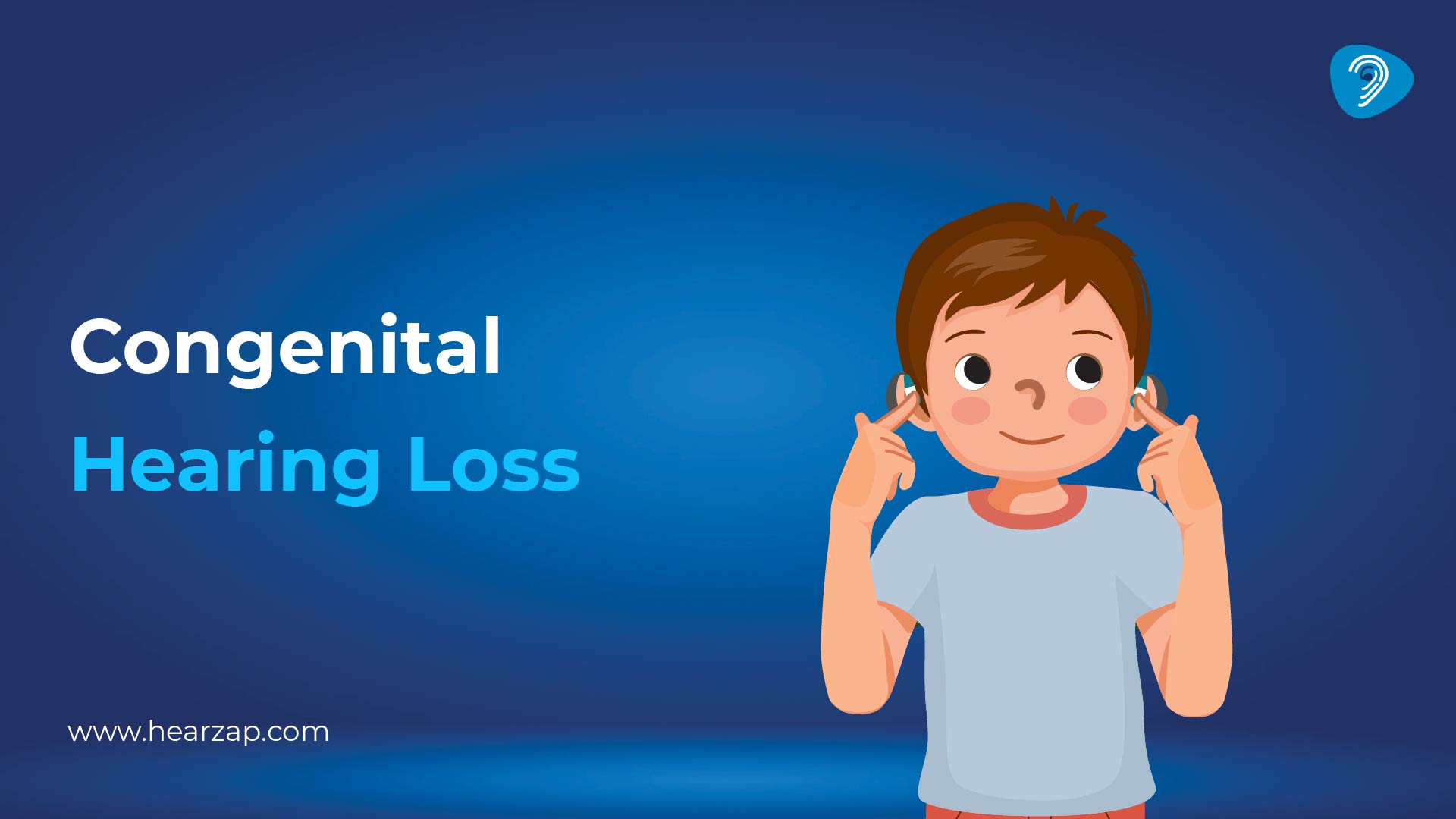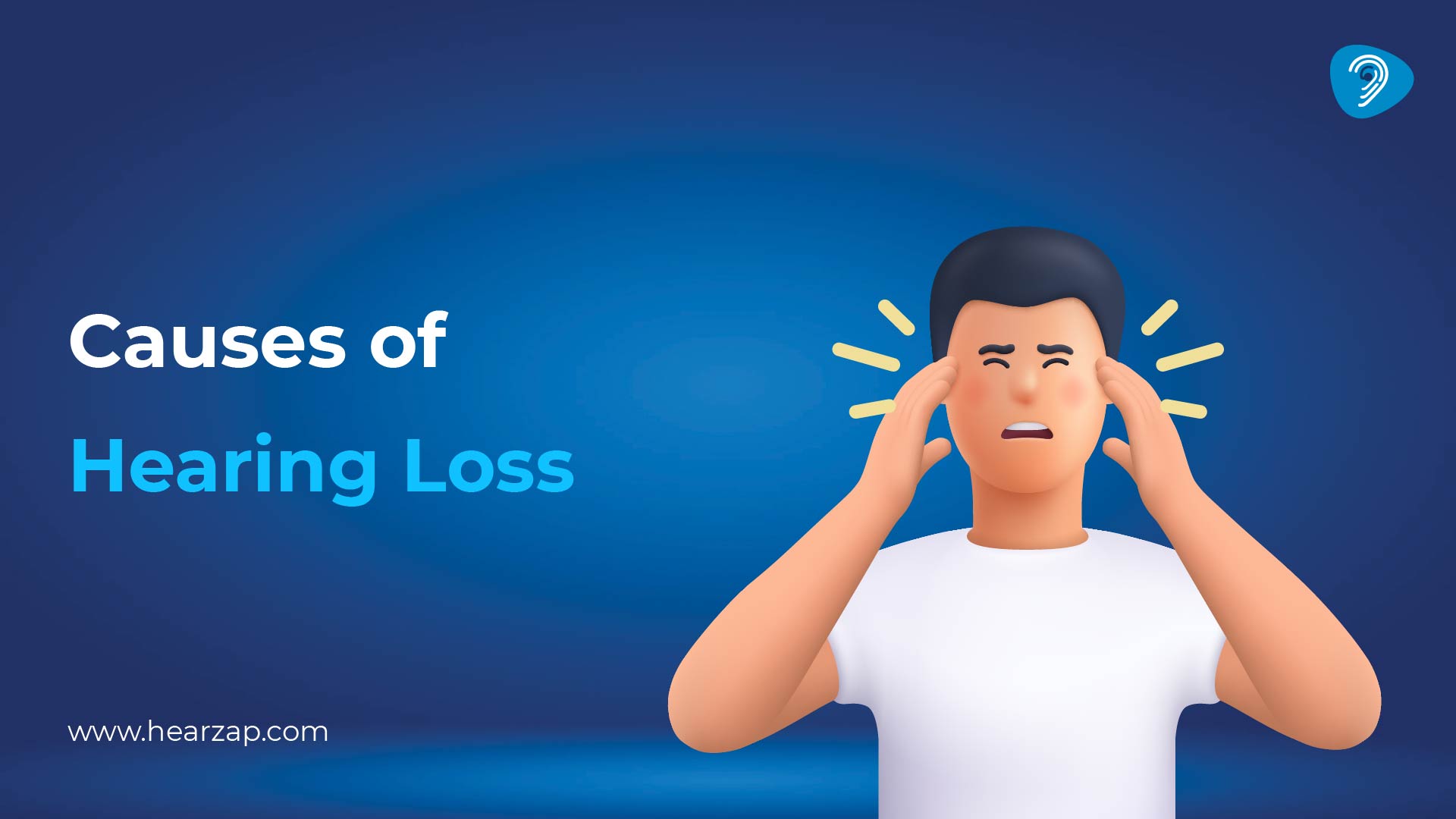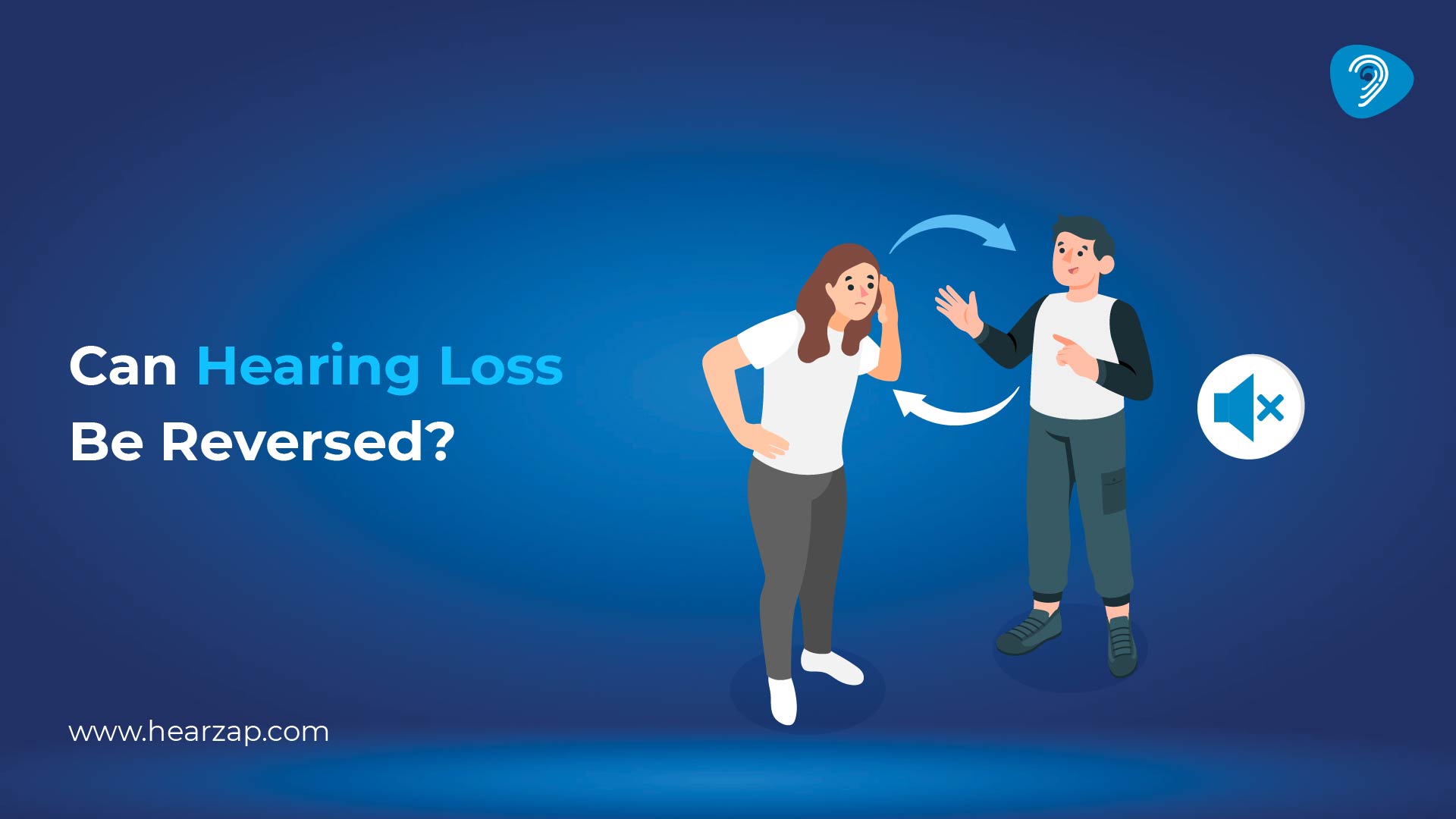HEARING LOSS
Congenital Hearing Loss Explained: Causes, Symptoms & Treatments
By Team Hearzap | Oct. 10, 2025

Hearing shapes bonding, language, and safety from day one. When sound is reduced at birth, families often feel unprepared and worry about missing the early window for speech. This guide explains congenital hearing loss, shows practical signs to watch for, lists common congenital hearing loss causes, and outlines realistic congenital hearing loss treatment options you can discuss with your clinician.
What is Congenital Hearing Loss?
Congenital hearing loss means reduced hearing present at birth in one or both ears. It is different from changes that appear later due to illness, noise, or ageing. The shift can be mild, moderate, severe, or profound. Some children hear certain pitches better than others, so voices may sound unclear even when loud enough.
Early checks matter because the brain builds sound pathways fastest in the first years. Most hospitals run a quick screen before discharge. If a baby does not pass, the next step is a full hearing test with an audiologist. Quick action helps keep communication on track without rushing or guessing.
Symptoms of Congenital Hearing Loss
Children do not all react the same way. Two babies with similar results can behave differently at home. Use the signs below as prompts to seek a hearing test rather than as a final answer.
Early Signs in Newborns and Infants
- Little or no startle to sudden noises after the first few weeks.
- Delayed cooing or babbling compared with peers.
- Not settling to a parent’s voice or lullaby.
- Not turning toward familiar voices by around six months.
- Difficulty locating where a sound comes from.
These clues do not prove a diagnosis, but they do justify timely checks. Addressing hearing loss in children early makes daily routines, such as feeding, reading, and bath time, more practical and less frustrating.
Signs in Older Children and Adults
- Asking for repetition or turning one ear toward the speaker.
- Struggling in noisy rooms or group conversations.
- Missing quiet consonants, so speech seems muffled.
- Turning the TV up while others prefer a lower volume.
- Tiring quickly after school because listening takes extra effort.
Causes of congenital hearing loss
There is no single pathway. Congenital hearing loss falls into two broad groups: genetic and non-genetic. Knowing the likely cause helps teams plan monitoring and tailor congenital hearing loss treatment.
Genetic Causes
Inherited factors can affect the inner ear (cochlea), the auditory nerve, or the tiny middle-ear bones that pass sound along.
- Non-syndromic forms involve hearing alone. A common example involves changes in the GJB2 gene (connexin 26).
- Syndromic forms occur with other features—vision differences, kidney findings, balance issues, or distinctive growth patterns.
- Inheritance can be autosomal recessive, dominant, or X-linked. Sometimes a child is the first in the family because the change is new.
A genetics referral can clarify recurrence risk and whether to screen for related health needs. It also supports family planning without predicting any one child’s outcome.
Non-Genetic Causes
Not all congenital hearing loss causes are inherited. Examples include:
- Infections during pregnancy, such as rubella or cytomegalovirus.
- Prematurity, low birth weight, or limited oxygen around delivery.
- Ototoxic medications that were essential for survival but carry a hearing risk.
- Ear canal atresia, ossicle malformation, or cochlear differences are seen on imaging.
- Severe newborn jaundice, poorly controlled maternal diabetes, or significant noise or chemical exposure.
When exploring the wider causes of hearing loss, remember that ear infections, loud music, and ageing are usually related to changes after birth.
Diagnosis and Screening
The process is stepwise. A screen suggests whether more testing is needed; it does not label a child. If follow-up is advised, try not to delay. Earlier answers reduce worry and open access to support.
What to Expect on Test Day
Parents often ask what the appointment involves. Bring snacks, a favourite toy, and naptime supplies. For babies, the audiologist may schedule the hearing test to overlap with a natural sleep so wires and ear tips can be placed without fuss. Older children practise simple games – dropping a block in a bucket when they hear a beep, or pointing to picture cards. Results are explained with clear next steps; if they differ from home observations, another check is usually arranged.
Common tools:
- Otoacoustic emissions (OAE): a small soft tip plays gentle clicks while a probe records a tiny echo from the cochlea. It is quick and comfortable.
- Auditory brainstem response (ABR): sensors on the head measure how the hearing nerve and brainstem respond to sound. Babies often sleep through it.
- Tympanometry: checks eardrum movement and middle-ear pressure to separate fluid or blockage from inner-ear changes.
- Behavioural audiometry: age-appropriate games or headphone tests map hearing across pitches.
Keep notes about pregnancy history, newborn care, family history, and language milestones. Share everyday examples - places your child struggles with and moments that feel easy. This detail sharpens decisions about amplification, classroom supports, and review timing.
Practical Everyday Tips
Small tweaks make daily listening easier for hearing loss in children:
- Face the child when speaking and reduce background noise where possible.
- Use short sentences, then pause. Give time for listening and replies.
- At dinner, turn off the TV and place the child where lips and faces are visible.
- Build a habit of device checks each morning so school days start smoothly.
Treatment for Congenital Hearing Loss
The best plan matches the type and degree of change, the child’s age, and family goals. The aim is consistent access to clear sound and confident communication. Technology helps, and coaching turns access into skills.
Hearing Devices
- Hearing aids: For many mild to moderate sensorineural losses, well-fitted devices amplify specific pitches so speech becomes clearer without harshness. Modern models are small, rechargeable, and can pair with classroom microphones.
- Bone-conduction systems: Useful when ear canals are absent or the middle ear cannot pass sound well. Softbands are common in infancy; implanted options may follow later.
- Cochlear implants: Considered when hearing aids bring limited benefit in severe to profound sensorineural loss. The system bypasses damaged hair cells to stimulate the nerve directly. Assessment includes imaging, language review, and counselling.
- Assistive listening technology: Remote microphones, captions, and alerting devices lower listening effort in noise and at a distance.
Device choice is only the start. Consistent daily wear, check-ups, and fine-tuning make the difference. Families often track hours worn and note which places - car rides, playgrounds, dinner tables - felt easier or harder; those notes guide adjustments.
Therapy and Support
- Speech and language therapy focuses on listening, vocabulary, and clear speech matched to age and hearing access.
- Auditory training uses games to notice soft sounds, tell similar words apart, and follow talk in background noise.
- Family coaching turns daily routines into conversation practice: naming actions while dressing, reading picture books, and pausing so the child can take a turn.
- Educational planning improves classrooms with seating, acoustic treatment, and teacher microphones. Clear plans reduce fatigue and missed details.
- Well-being and identity matter. Families may choose spoken language only, a bilingual path with sign language, or a Deaf cultural route. Informed choice and respect are central.
Throughout childhood, regular review keeps support aligned with growing school demands. Teens learn self-advocacy: caring for devices, explaining needs, and asking for captions when needed.
Conclusion
Congenital hearing loss is varied but manageable. Understanding the likely congenital hearing loss causes helps you plan sensible checks and long-term monitoring. When needed, congenital hearing loss treatment may include hearing aids, bone-conduction options, cochlear implants, and classroom tools, paired with therapy that fits everyday life.
If you suspect a change, arrange a hearing test with a qualified audiologist. Write down situations that are hardest and share them during appointments. Small, early steps compound over time, especially when home, school, and clinic teams work together. Share updates with teachers and relatives so support stays consistent across settings every day too.
FAQs
What is congenital hearing loss?
It is reduced hearing present at birth in one or both ears. Degrees vary from mild to profound and may affect some pitches more than others.
What is the most common congenital hearing loss?
In many regions, permanent bilateral sensorineural changes often arise from non-syndromic genetic factors such as variants in the GJB2 gene. Prematurity and infections in pregnancy are also frequent contributors in some settings.
How do you diagnose congenital hearing loss?
Clinicians combine newborn screening results with OAE, ABR, tympanometry, and age-appropriate behavioural audiometry. Imaging and medical assessments may follow if a structural difference or a broader syndrome is suspected.
What are the symptoms of congenital hearing loss?
In babies: reduced startle, delayed babble, and not turning to voices. In older children: frequent repetition requests, difficulty in noise, higher TV volume, and listening fatigue.
Can congenital hearing loss be prevented?
Some paths can be reduced - vaccination against rubella, good antenatal care, careful use of ototoxic medicines, and prompt treatment of severe jaundice. Others are genetic and not preventable, so the focus shifts to early detection and timely support.
Related Blogs

How Hearing Loss Affects Daily Life

Causes of Hearing Loss

Can Hearing Loss Be Reversed
Contact us
We are here for all your hearing needs, from hearing tests to hearing aids. Fill out the form below, and we will give you a call soon.
Please enter a valid mobile number with 10 digits.
Recent Blogs
By None | Nov. 28, 2025
By None | Nov. 27, 2025
By None | Nov. 26, 2025
By None | Nov. 24, 2025
By None | Nov. 20, 2025









